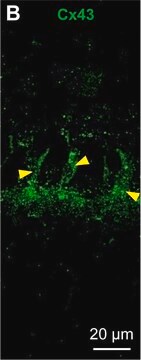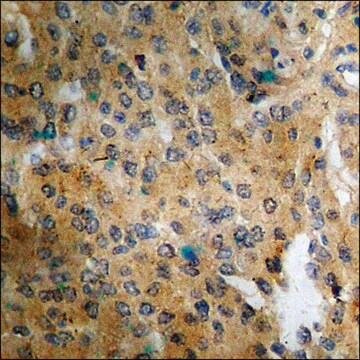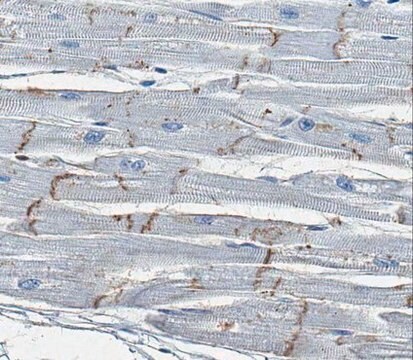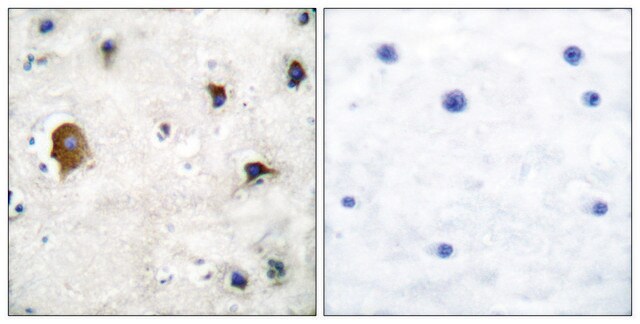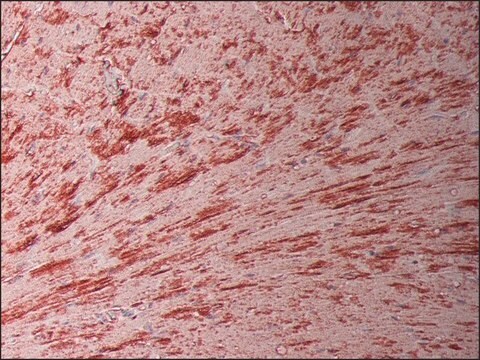MABT903
Anti-Connexin 43 Antibody, N-terminal Antibody, clone P1E11.B19
clone P1E11, from mouse
Synonim(y):
Gap junction alpha-1 protein, CX43, Gap junction 43 kDa heart protein
About This Item
Polecane produkty
pochodzenie biologiczne
mouse
Poziom jakości
forma przeciwciała
purified immunoglobulin
rodzaj przeciwciała
primary antibodies
klon
P1E11, monoclonal
reaktywność gatunkowa
mouse, rat, human
reaktywność gatunkowa (przewidywana na podstawie homologii)
bovine (based on 100% sequence homology), rabbit (based on 100% sequence homology), horse (based on 100% sequence homology), canine (based on 100% sequence homology), rhesus monkey (based on 100% sequence homology), chicken (based on 100% sequence homology), hamster (based on 100% sequence homology), porcine (based on 100% sequence homology)
metody
immunocytochemistry: suitable
western blot: suitable
izotyp
IgG1κ
numer dostępu NCBI
numer dostępu UniProt
Warunki transportu
ambient
docelowa modyfikacja potranslacyjna
unmodified
informacje o genach
bovine ... Gja1(281193)
chicken ... Gja1(395278)
dog ... Gja1(403418)
horse ... Gja1(100067229)
human ... GJA1(2697)
mouse ... Gja1(14609)
rabbit ... Gja1(100008935)
rat ... Gja1(24392)
rhesus monkey ... Gja1(714344)
Opis ogólny
Specyficzność
Immunogen
Zastosowanie
Cell Structure
Western Blotting Analysis (WB): A representative lot detected Connexin 43 in NRK cells (Courtesy of Joell Solan in Paul Lampe s Lab at Fred Hutchinson Cancer Research Center, Seattle, WA).
Western Blotting Analysis: A representative lot detected Connexin 43 in Western Blotting applications (Kalcheva, N., et. al. (2007). Proc Natl Acad Sci USA. 104(51):20512-6).
Western Blotting Analysis: 1-4 µg/mL from a representative lot detected Connexin 43 in 10 µg of rat and mouse heart tissue lysates.
Immunocytochemistry Analysis: A representative lot detected Connexin 43 in Immunocytochemistry applications (Gellhaus, A., et. al. (2004). J Biol Chem. 279(35):36931-42).
Western Blotting Analysis: A representative lot detected Connexin 43 in Western Blotting applications (Goldberg, G.S., et. al. (2002). J Biol Chem. 277(39):36725-30).
Western Blotting Analysis: A representative lot detected Connexin 43 in Western Blotting applications (Solan, J.L., et. al. (2003). J Cell Sci. 116(Pt 11):2203-11).
Jakość
Western Blotting Analysis: 1 µg/mL of this antibody detected Connexin 43 in 10 µg of human heart tissue lysates.
Opis wartości docelowych
Postać fizyczna
Przechowywanie i stabilność
Inne uwagi
Oświadczenie o zrzeczeniu się odpowiedzialności
Nie możesz znaleźć właściwego produktu?
Wypróbuj nasz Narzędzie selektora produktów.
Kod klasy składowania
12 - Non Combustible Liquids
Klasa zagrożenia wodnego (WGK)
WGK 1
Certyfikaty analizy (CoA)
Poszukaj Certyfikaty analizy (CoA), wpisując numer partii/serii produktów. Numery serii i partii można znaleźć na etykiecie produktu po słowach „seria” lub „partia”.
Masz już ten produkt?
Dokumenty związane z niedawno zakupionymi produktami zostały zamieszczone w Bibliotece dokumentów.
Nasz zespół naukowców ma doświadczenie we wszystkich obszarach badań, w tym w naukach przyrodniczych, materiałoznawstwie, syntezie chemicznej, chromatografii, analityce i wielu innych dziedzinach.
Skontaktuj się z zespołem ds. pomocy technicznej
